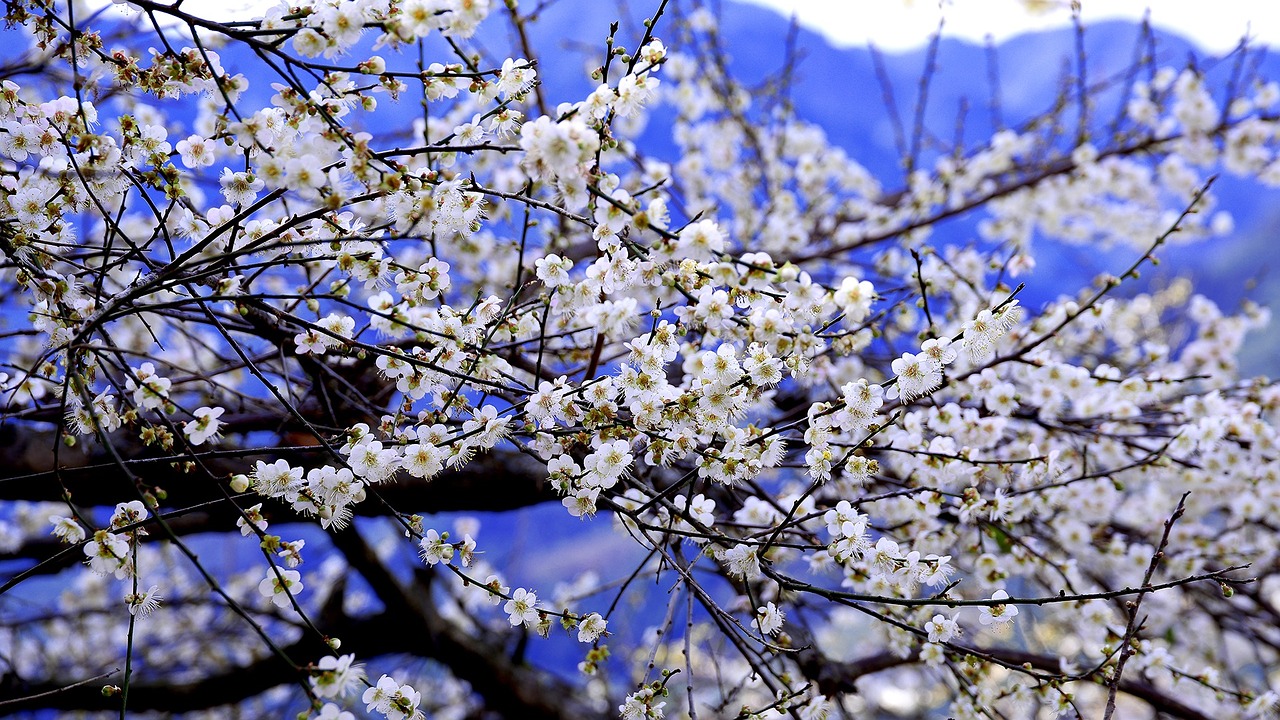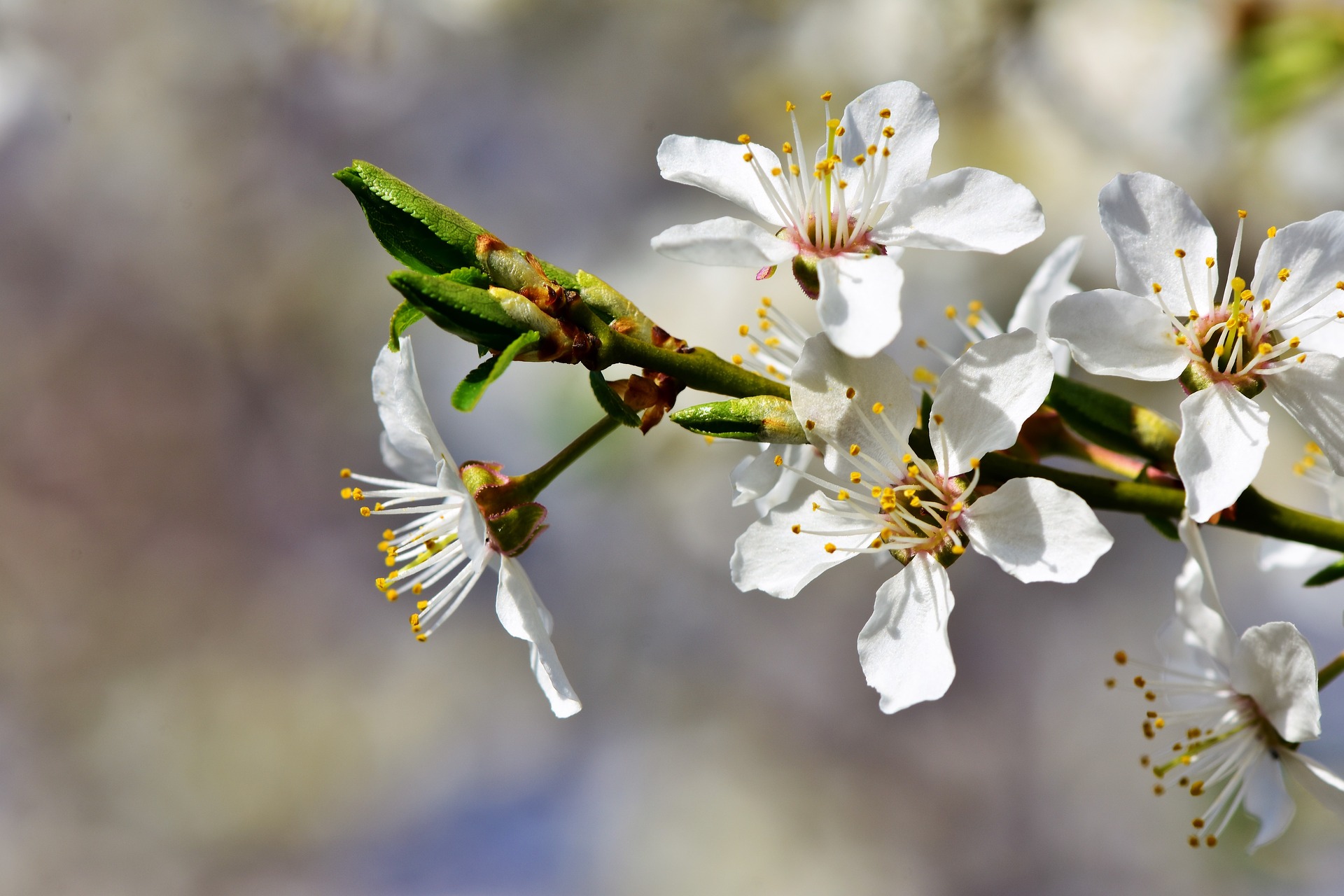
The sword is sharpened by constant rubbing; plum blossoms emit their fragrance by having endured the strong cold of winter.
The plum blossom is a recurring symbol within the Choy Li Fut 蔡李佛 style. Approximately twenty forms in the system bear a reference to this flower within its name: Siu Mui Fa Kuen 小梅花拳 (Small Plum Blossom Hand Form), Mui Fa Bot Gwa Kuen 梅花八卦拳 (Plum Blossom Pa Kwa Hand Form), Mui Fa Dahn Do 梅花单刀 (Plum Blossom Broadsword), Mui Fa Cheung 梅花槍 (Plum Blossom Spear)... One wonders then why there is so much obsession with this flower, but before examining its relationship with Choy Li Fut, let's first see what it represents in the Chinese mentality.
The plum blossom in Chinese culture:
The plum blossom (梅花, Mandarin mei hua; Cantonese mui fa), together with the orchid, chrysanthemum and bamboo, represent the ideal virtues of the Chinese nation: resistance, purity, humility and rectitude, respectively.
The plum blooms in winter, defying ice and snow, so this flower is a symbol of resistance, hope, purity and transience of life. The plum blossom is thus a reminder that, in the middle of winter, a new spring is to come. As one proverb says, "the fragrance of the plum blossom comes from bitterness and cold."

This flower has been object of admiration and representation in all kinds of arts for many centuries, from painting to poetry. Zhu Xi 朱熹, a Confucian scholar of the Song dynasty 宋朝, associated the plum blossom to the four characteristics or virtues of Heaven: great potential in the bud, prosperity in the flower, harmony in the fruit and righteousness in maturity.
Also in the Song Dynasty, Lu You 陸游 dedicated a large part of his poems to this flower, for which he had great admiration, and Su Dongpo 苏东坡, one of China's greatest poets, wrote in one of his verses:
The beauty of the plum goes beyond the bitter taste of the fruit.
The popularity of the flower is such that in ancient times there were coins in the shape of a plum blossom.
The plum blossom in Choy Li Fut:
During the Qing Dynasty 清朝, the anti-Manchu revolution, with which Choy Li Fut was so closely related in its early years, adopted the plum blossom as a revolutionary emblem of resistance; until then the peony had occupied the pre-eminent place as the Chinese national flower. Like the plum blossom, the Chinese nation and people aspired to flourish amid the oppression of the Manchu regime. In the vicissitudes, the spirit is tempered and internal strength is increased.
In addition to a revolutionary symbol, the Mui Fa or plum blossom refers, within the Chinese Martial Art, to a movement pattern characteristic of the King Mui branch 京梅 of Choy Li Fut. These forms are characterized by evasive movements, which leave the central line where the attack comes from to enter involving the opponent with circular movements and transitions in all directions (straight and diagonal). This is known as the Mui Fa or Plum Blossom pattern, as opposed to the Sup Ji 十字 or Cross pattern, more characteristic of the Fut-San 佛山 forms.
Finally, it is also said that the plum blossom symbolizes the human being, through its five petals that represent the four extremities and the head of a person.
We can now understand why this profusion of forms bearing this name and, perhaps, aspire to obtain for us the qualities of the plum blossom: perseverance, tenacity and purity.



2 thoughts on “The Plum Blossom as a symbol”
Very interesting post ! We’re can also find the plum blossom movement pattern in Wing Chun with the same goal. Actually, I think it comes from Fut-Shan 佛山 because Ip Man learnt Wing Chun there, and then, he used the plum flower symbol in his school at HK. I’ve had this footwork strategy in my learning.
Thank you Sihing Nico for your comment,
I actually don’t know much about Wing Chun… but both Wing Chun and Choy Li Fut developed in the same region and time, so they share a lot of cultural background and it’s normal they used the same symbols.
Talking about Choy Li Fut movements, the style origins are in King Mui, and from there it spread to Foshan (mainly through one of the founder’s disciples), where it changed and developed in its own way (Hung Sing Choy Li Fut 鴻勝蔡李佛), becoming, we can say, a different style. But still keeps some of its characteristics. Among the founder’s original forms, there was one called Gwok Fa Kyun 国花拳, later called Mui Fa Kyun 梅花拳. And in all Choy Li Fut branches there are many forms called Mui Fa…
We believe the movements of the Foshan branch of Choy Li Fut to be more direct, more straight forward, although myself I haven’t studied the Foshan branch in depth.
Anyway, the Wing Chun pattern of movement could be originated in Foshan, while King Mui branch of Choy Li Fut’s might have originated somewhere else, I believe. Anyway, Guangdong was a melting pot, so anything could be!
Thanks for sharing your views!